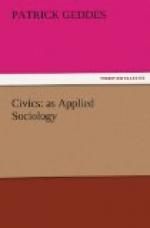Professor Geddes for more than twenty years has adopted this method of teaching sociology in the open air; “in the field,” as geologists would say....
This is much more than the study and the description of buildings and places of historical interest. His aim is first to study the way in which a city grows, always having due regard to its physical environment; secondly, by comparing like with like, as a naturalist compares the individuals of a species, or the species of a genus, to throw light on the laws which govern civic development, and thus to help forward and direct civic action.
All this is set forth with greater fulness in the Report which Professor Geddes has been asked to write for the Carnegie Dunfermline Trust. The purpose of the Report (printed, but not yet published) was to suggest the way in which the revenue of the Trust, amounting to L25,000, should be spent for the benefit of this ancient and historic town. The scheme, with its many pictures, real and ideal, of workshops, parks, culture-institutes—physical, artistic, and historical—will deeply interest even those who reject much of it as Utopian. But it is at least a Utopia specially adapted to a given place and time, one in which every feature of landscape and history is made the most of, one in which a beginning can be made at once, leaving room for further developments as occasion may serve. Moreover, it is penetrated through and through with the Republican ideal of bringing the highest truth within the reach of all.
Comte has pointed out, in the fifth chapter of his “General View of Positivism,” and elsewhere, that it is not enough to enunciate sound principles of social renovation unless they can be rendered visible and palpable. “The principal function of art,” he says, “is to construct types on the basis furnished by Science.... However perfectly the first principles of social renovation may be elaborated by thinkers, they will still not be sufficiently definite for the practical results.... But, at the point where Philosophy must always leave a void, Art steps in, and stimulates to practical action.... Hence, in the future, systematic formation of Utopias will become habitual; on the distinct understanding that as in every other branch of art, the ideal shall be kept in subordination to the real.”




